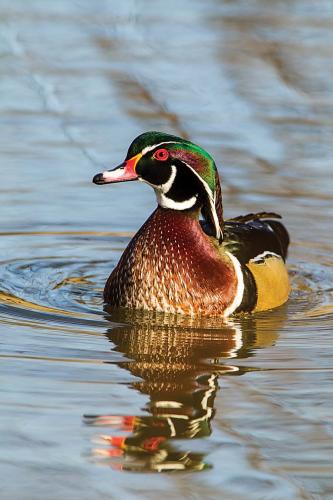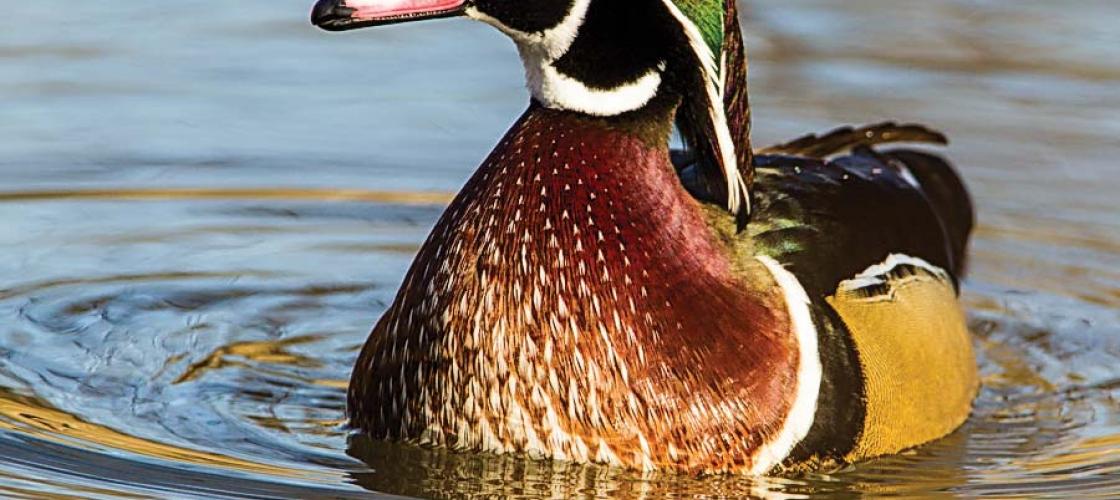Tomorrow is Cinco de Mayo! To get in the spirit, here are five things happening in nature to view and celebrate.
Hawthorns, our Missouri state flower, are blooming in open areas. These showy white flowers are found throughout the state on small shrubs and trees.
Wood ducks are hatching — high up in trees near water. Chicks are born ready –covered in down. Within a day, they will jump out on their own, from heights as much as 60 feet or more.
More about wood ducks:
Wood ducks form pairs in midwinter and usually have two broods a year. Clutches comprise 6-16 eggs, which are incubated 28-37 days.
Wood Ducks are best known by the bright colors that males show during the breeding season. A combination of purple, green, blue, red, white, and black make this a fascinating and beautiful animal.
Wood Ducks, like most ducks, live near water. They can be found at ponds and marshes, but also wooded rivers and large streams.
The Wood Duck is a popular game bird, and is second only to the Mallard in numbers shot each year in the United States.
Male catfish are building nests—to lure in females, fertilize the eggs, and guard them from predators until they hatch and can swim away.
More about catfish:
A sexually mature male selects and cleans a nest site and spawns with a female he lures there. After the female lays her mound of sticky, yellow eggs, the male fertilizes the mass, drives the female from the nest and begins guard duty. He protects the nest from predators and fans the eggs with his fins to keep them aerated and free from sediments. The eggs hatch in six to 10 days (depending on water temperature), and the compact school of fry remains near the nest a few days before dispersing. The male guards the fry until they leave.
Our major catfish species spawn during spring or summer when the water warms to an optimal temperature. Channel and blue catfish spawn at 70-84 degrees, but 80-81 degrees is considered best. Flatheads spawn at 66-75 degrees.
Honeybees, the official state insect of Missouri even though they are not native to the state, are swarming. Much of our diet relies on these cross pollinators. Without them, we wouldn’t enjoy many fruits, vegetables and flowers.
More about bees:
Bee pollination is critical to plant and human survival – beeswax and honey are just surplus gifts from this tiny wonder of nature.
There are about 3,500 species of bees in North America and more than 20,000 species of bees in the world. In fact, 33% of the food in the world comes from plants that rely on creatures to pollinate them.
People have used honey and beeswax for thousands of years and brought honeybees to this country from Europe. Without honeybees we would not have as many fruits and vegetables to eat!
And last, goldfinches are feeding on dandelion seeds. You can see these bright yellow birds with black foreheads around backyards and feeders. Their acrobatics are as showy as their colors.
More about goldfinches:
To encourage goldfinches into your yard, plant native thistles and other composite plants, as well as native milkweed. Almost any kind of bird feeder may attract American Goldfinches, including hopper, platform, and hanging feeders, and these birds don’t mind feeders that sway in the wind. You’ll also find American Goldfinches are happy to feed on the ground below feeders, eating spilled seeds. They’re most attracted to sunflower seed and nyjer.
To protect American Goldfinches from contagious diseases at feeders, keep the ground well-raked.
Discover more nature at http://mdc.mo.gov.










Recent Posts
























